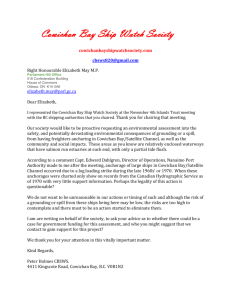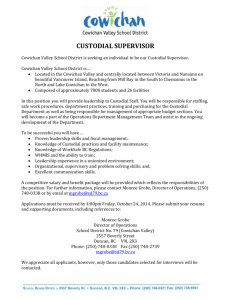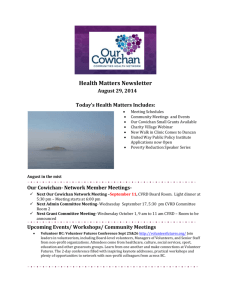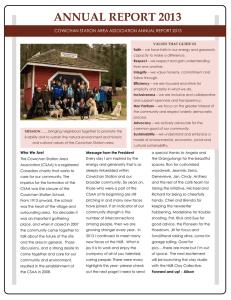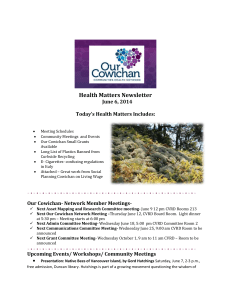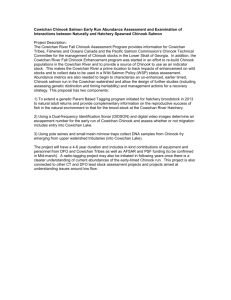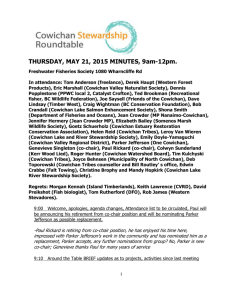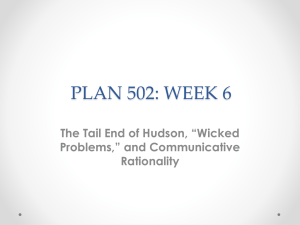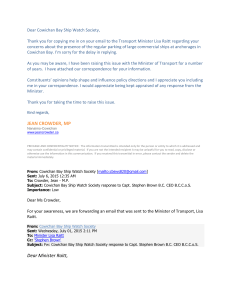Cowichan Roundtables … a made in Cowichan Process Embracing crisis
advertisement
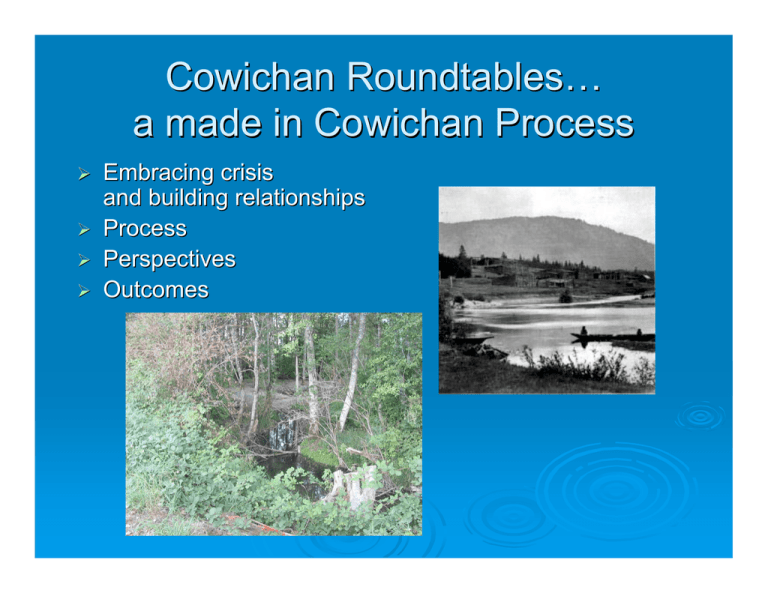
Cowichan Roundtables… a made in Cowichan Process Embracing crisis and building relationships Process Perspectives Outcomes The Next 20 Minutes…. The Roundtables Stewardship Fisheries Water and governance The Dynamic – what makes it work? Outcome examples Challenges And the bottom line… Cowichan Stewardship Roundtable Working together – Making a Difference… Cowichan Stewardship Roundtable One of three linked Cowichan Roundtables Deals with productive capacity of the watershed Who Plays? • First Nations, Sr. Level Government Agencies, Local Government, Industry, Stewardship Groups, Stakeholders What are the Rules? • • • • • Consensus based and open Watershed goals prioritized Address limiting factors and needs of participants Pooling of resources, expertise and influence Flexible and Opportunistic… What Makes it Work? Initially – Trust building exercise Focus on commonalities – not differences Low Hanging Fruit In Crisis lies Opportunity… Outcome Example – Stoltz Slide Outcome Example – Stoltz Slide Slope failure – point source of sediment input of massive scale Documented negative impacts Common goal – strange bedfellows… Common vision – strong partnership – well funded Pooled expertise – challenging project completed – benefits to all Outcome Example – Cowichan Recovery Strategy Outcome Example – comprehensive road map Science based Coordinated implementation plan Common goals and visions Identifies: Population recovery actions Habitat recovery actions Stewardship recovery actions Evaluation and monitoring Identifies funding requirements Cowichan Fisheries Roundtable Ensuring fish for the community The process Dealing with resources vital to the people Water Salmon Brings together groups of people directly benefiting and impacted by the quality of resources CT, Fed, Provincial, Industry, Recreation CT main source of food and cultural components Other significant cultural components Trust for years First Nations, DFO, commercial and recreation on different sides of table Principles and goals are competing Continue to gain each others trust Communication is the key From Cowichan Tribes view DFO previously has laid out how things to be done …now realize that they must listen and begin to accommodate CT buy in Challenges Positive outcomes Able to utilize local expertise to assess the conditions of the river and health of stocks Transfer of some authority for management of our resources Assessment methods need to be further refined or improved to provide consistent and reliable estimates – including local knowledge Long term objectives First Nations and Canada / BC bring different priorities to the table First Nations are looking for and have a mandate to recognize the right for aboriginal people to fish for livelihood Seeking recognition of governance over the stewardship of the resources Sole management of fisheries in specific areas Cowichan Water Roundtable Total Area = 930 km2 Cowichan Lake area = 63 km2 “Crisis” as opportunity for collaboration and bridge building In 2003, lake storage was within 5 days of being totally exhausted and mill shutdown Without drastic early action to reduce river flows, 2006 could have been ‘the shutdown year’ In October 2006, spawning Chinook had to be moved by truck due to inadequate river flow The Chinook escapement was the lowest on record Lack of supply will have serious economic, effluent dilution, and ecological consequences ONLY 5 days of storage remained or Cowichan would have dried up! De c2 7 Oc t2 8 N ov 27 28 Se p Ju l3 0 A ug 29 30 Ju n 31 M ay 1 M ay 1 M ar 2 31 A pr Day of the Year Lake Level (Metres above GSC Datum) 164.75 164.50 164.25 164.00 163.75 163.50 163.25 163.00 162.75 162.50 162.25 162.00 161.75 161.50 161.25 Actual Lake Level - 2000 Actual Lake Level - 2003 Target Rule Curve Zero Storage Crest of Weir Ja n 1 113 112 111 110 109 108 107 106 105 104 103 102 101 Ja n Lake Level (feet above local datum) 2003 Crisis - A very near miss! Process towards a Water Roundtable Recognition that water supply is a major limiting factor to both stewardship and production Stewardship Roundtable proposes and funds basin based water management plan Recognition that multiple views need to be incorporated in design of plan Plan needs to be facilitated by a neutral and overarching organization Who is involved? Funding Partners CVRD, Cowichan Tribes, DFO, MoE, Catalyst Paper Corporation, Pacific Salmon Commission Water Management Forum 26 people -- varied interests and geographic locations in the Basin Consulting team Led by Westland Resource Group The Public Inform plan content and support implementation Plan highlights 1 Vision, 6 Goals, 23 Objectives, 89 Actions The Six Goals: 1. Demand management 2. Increase supply 3. Protect aquatic ecosystems 4. Reduce flooding impacts 5. Research, education, public outreach 6. Improved water governance Proposed Governance model CVRD Chair Municipalities Farmers Min. of Ag. and Lands Cowichan Tribes Economic Dev. Catalyst Paper Timber Companies Cowichan Basin Water Advisory Council School Districts Fisheries & Oceans Canada MoE Fisheries Recreational Fisheries MoE Water Stewardship Div. Lakeshore Residents Eco-tourism Lower Basin Residents Riverfront Residents Advancing the Plan Until the plan is adopted and implemented, there will be no benefits of coordinated, comprehensive water management in the Cowichan Basin Challenges… Sharing Power… Gaining Trust – Communicating Time, effort, resources… Bottom Line… To Achieve real and lasting gains, an inclusive, empowered, community driven process for watershed decision making is not an option – it is a requirement Bottom up process – must be supported and empowered by Sr. Govt. – lead by community We are losing fish habitat every day – without any laws being broken. A proactive planning approach is required. Regulatory capacity is important and necessary but the big gains will come from community driven planning processes. Good public policy needs articulated implementation strategy with links to community. Water (Governance) (Healthy River) Stewardship Round Table (Healthy Production) Fisheries Round Table (Healthy Harvest) • In high risk situations, the value of the round table processes is in building the knowledge together, building the relationships, and building the capacity using pooled resources with people you would otherwise never meet.
